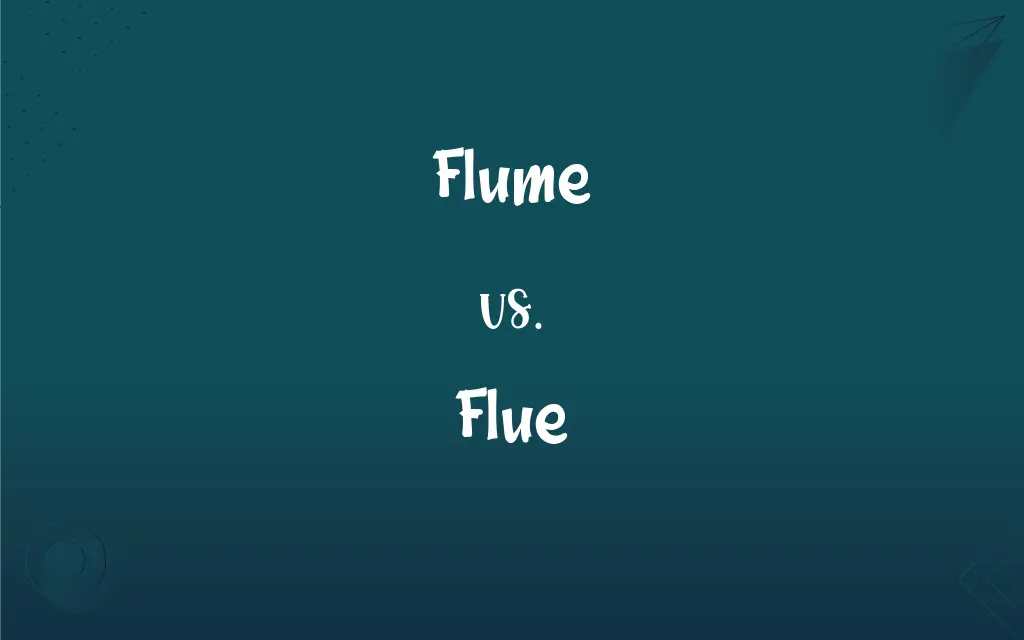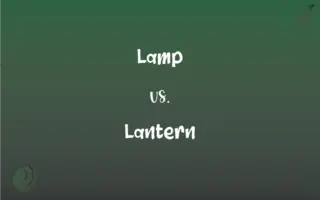Flume vs. Flue: What's the Difference?
By Aimie Carlson & Janet White || Updated on March 4, 2024
A flume is a man-made channel for water, often for transport, while a flue is a duct for smoke and gases, typically in a chimney.

Key Differences
Flumes are engineered water channels designed to divert or transport water for various purposes, such as irrigation, hydroelectric power generation, or water rides in amusement parks. They are often constructed above ground and can be made from various materials, including wood, metal, or concrete. On the other hand, flues are ducts, pipes, or openings in chimneys designed to expel smoke, gases, and other combustion byproducts from fireplaces, stoves, furnaces, or boilers to the outdoors.
Flumes are characterized by their ability to manage and control the flow of water in open-air settings, making them visible structures in landscapes or industrial sites. In contrast, flues are integral components of heating systems and fireplaces, often hidden within walls or chimneys. They are critical for fire safety and air quality, requiring proper sizing, installation, and maintenance to function effectively.
While flumes play a significant role in water management and distribution, contributing to agricultural productivity, energy generation, and recreational activities, flues are essential for the safe operation of heating appliances and fireplaces, protecting indoor environments from smoke, toxic gases, and fire hazards.
Comparison Chart
Definition
A man-made water channel for transport.
A duct for smoke and gases in a chimney.
Primary Use
Water diversion and transport.
Expulsion of combustion byproducts.
ADVERTISEMENT
Location
Often above ground in open air.
Within walls, chimneys, or roofs.
Materials
Wood, metal, concrete.
Metal, clay, concrete.
Importance
Manages water flow for various purposes.
Ensures safety and air quality indoors.
Flume and Flue Definitions
Flume
Part of irrigation systems.
The flume transported water across the farm efficiently.
Flue
Part of a chimney for venting gases.
We cleaned the flue to prevent chimney fires.
ADVERTISEMENT
Flume
A channel designed to transport water.
The flume directed water to the hydroelectric plant.
Flue
Essential for gas appliances' safety.
The furnace's flue was inspected for blockages.
Flume
Used in mining for water diversion.
Miners built a flume to separate gold from sediment.
Flue
A pipe, tube, or channel for conveying hot air, gas, steam, or smoke, as from a furnace or fireplace to a chimney.
Flume
An artificial river, especially in amusement parks.
We rode the log through the flume ride.
Flue
An organ pipe sounded by means of a current of air striking a lip in the side of the pipe and causing the air within to vibrate. Also called labial.
Flume
A narrow gorge, usually with a stream flowing through it.
Flue
The lipped opening in such a pipe.
Flume
An open artificial channel or chute carrying a stream of water, as for furnishing power or conveying logs.
Flue
A fishing net.
Flume
A very small swimming pool designed with a propeller or pump to generate a current, allowing a swimmer to swim in place.
Flue
A pipe or duct that carries gaseous combustion products away from the point of combustion (such as a furnace).
Flume
A ravine or gorge, usually one with water running through.
Flue
An enclosed passageway in which to direct air or other gaseous current along.
Flume
An open channel or trough used to direct or divert liquids.
Flue
A woolly or downy substance; down, nap; a piece of this.
Flume
(transitive) To transport (logs of wood) by floating them along a water-filled channel or trough.
Flue
In an organ flue pipe, the opening between the lower lip and the languet.
Flume
A stream; especially, a passage channel, or conduit for the water that drives a mill wheel; or an artifical channel of water for hydraulic or placer mining; also, a chute for conveying logs or lumber down a declivity.
Flue
An inclosed passage way for establishing and directing a current of air, gases, etc.; an air passage
Flume
A narrow gorge with a stream running through it
Flue
In an organ flue pipe, the opening between the lower lip and the languet.
Flume
Watercourse that consists of an open artificial chute filled with water for power or for carrying logs
Flue
Light down, such as rises from cotton, fur, etc.; very fine lint or hair.
Flume
A tool for measuring water flow.
The engineer used a flume to gauge the stream's speed.
Flue
Flat blade-like projection on the arm of an anchor
Flue
Organ pipe whose tone is produced by air passing across the sharp edge of a fissure or lip
Flue
A conduit to carry off smoke
Flue
A duct for smoke in buildings.
Smoke escaped through the flue into the open air.
Flue
Aids in proper combustion in fireplaces.
A well-designed flue keeps the living room smoke-free.
Flue
Regulates air flow and quality.
The flue must be open when the fireplace is in use.
FAQs
Can flumes be used for energy generation?
Yes, flumes can be part of hydroelectric power systems, directing water to turbines that generate electricity.
Why is it important to maintain flues?
Regular maintenance of flues is crucial to prevent blockages that could lead to dangerous gas build-ups and fire hazards.
What is a flume used for?
A flume is used to transport water for various purposes, including irrigation, energy generation, and recreational activities.
Are flumes only found outdoors?
While flumes are typically outdoor structures, they can also be found indoors in settings like water parks.
What is the purpose of a flue?
A flue is designed to safely expel smoke, gases, and other byproducts of combustion from buildings to the outdoors.
What materials are flumes made of?
Flumes can be constructed from wood, metal, or concrete, depending on their intended use and location.
Can flues be used with all types of fuels?
Flues are used with a variety of fuels, including wood, coal, gas, and oil, each requiring proper design for safe venting.
Are flumes safe for recreational use?
Flumes designed for recreational use, such as water slides, are built to be safe with appropriate safety features and regulations.
What happens if a flue is blocked?
A blocked flue can lead to dangerous conditions, including carbon monoxide buildup and increased fire risk.
What types of buildings need flues?
Buildings with fireplaces, stoves, furnaces, or boilers typically require flues to vent combustion gases.
How does water flow in a flume?
Water flows through a flume primarily by gravity, allowing for controlled movement from higher to lower elevations.
How are flues cleaned?
Flues are cleaned using special brushes and tools to remove soot, creosote, and other debris that can accumulate and cause blockages.
How do flumes benefit agriculture?
Flumes facilitate water transport for irrigation, improving agricultural productivity by ensuring consistent water supply.
Can flue design impact heating efficiency?
Yes, the design of a flue can significantly impact the efficiency of heating appliances by affecting airflow and combustion quality.
How do flues work?
Flues work by creating a draft that draws combustion gases up and out of buildings, utilizing the principle of hot air rising.
What are the environmental considerations for flumes?
The construction and operation of flumes must consider potential impacts on water resources, wildlife, and habitat conservation.
What is the difference between a flume and a canal?
A flume is a man-made channel specifically for water transport, often elevated, while a canal is a larger waterway for navigation and irrigation, usually at ground level.
Can flumes affect local ecosystems?
Flumes can impact local ecosystems by altering water flow and availability, requiring careful planning and management.
Do all homes with chimneys have flues?
Yes, chimneys are equipped with flues to safely vent smoke and gases from indoor fireplaces or stoves.
Is installing a flue a DIY project?
Installing a flue involves critical safety considerations and should typically be done by professionals to ensure proper ventilation and compliance with regulations.
About Author
Written by
Aimie CarlsonAimie Carlson, holding a master's degree in English literature, is a fervent English language enthusiast. She lends her writing talents to Difference Wiki, a prominent website that specializes in comparisons, offering readers insightful analyses that both captivate and inform.
Co-written by
Janet WhiteJanet White has been an esteemed writer and blogger for Difference Wiki. Holding a Master's degree in Science and Medical Journalism from the prestigious Boston University, she has consistently demonstrated her expertise and passion for her field. When she's not immersed in her work, Janet relishes her time exercising, delving into a good book, and cherishing moments with friends and family.































































